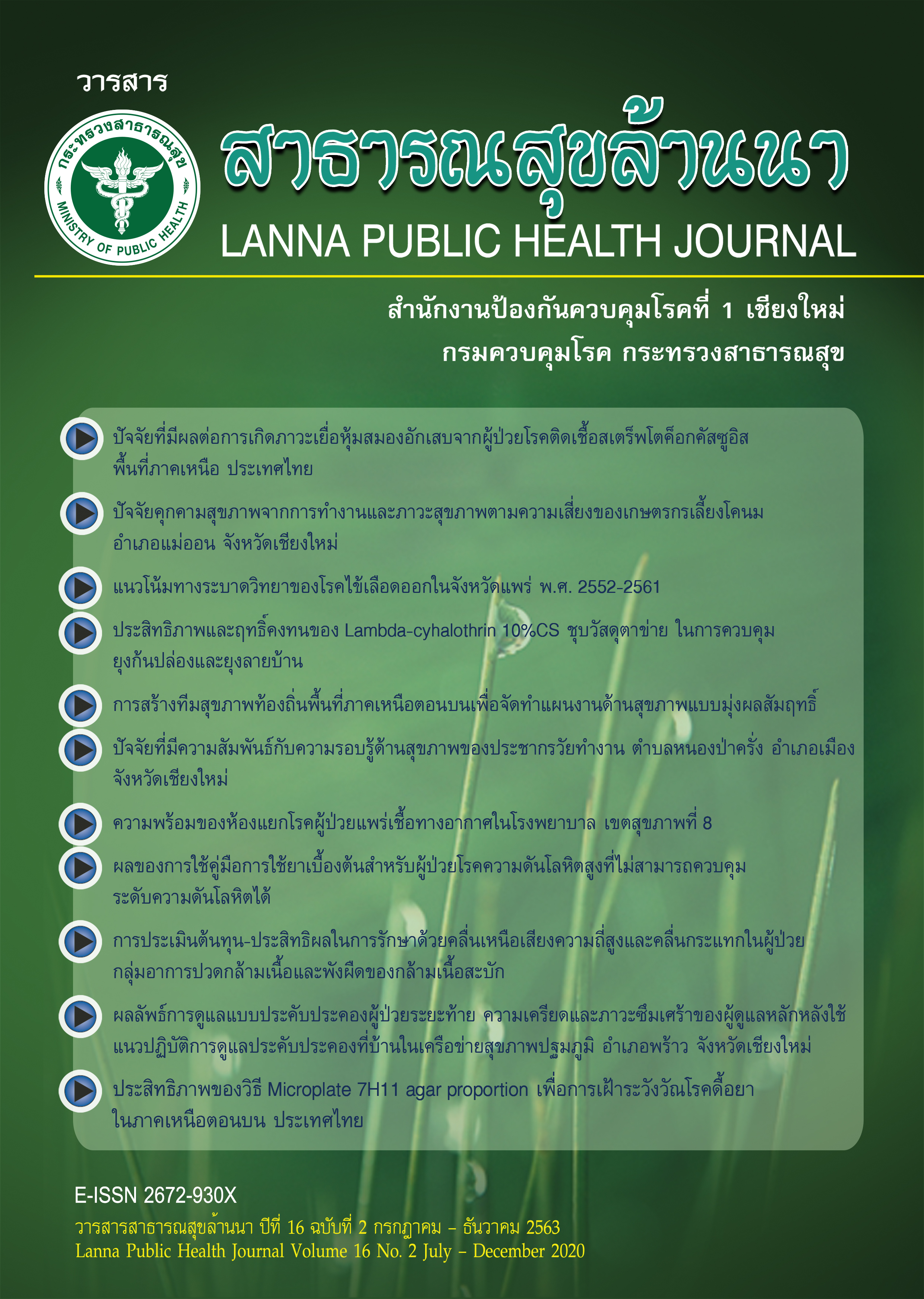Cost-Effectiveness Analysis of Ultrasound Therapy and Shockwave Therapy for Patients with Myofascial Pain Syndrome of Scapular Muscles
Keywords:
Ultrasound diathermy, Shockwave therapy, Cost-effectiveness, Utility, Myofascial pain syndromeAbstract
The study of a parallel trial with two groups and single-blinded experiment, aimed to compare the cost-effectiveness and utility of ultrasound diathermy (USD) and shockwave therapy (SWT) in patients with myofascial pain syndrome of the scapular muscles. The experiment randomly divided 56 patients into 2 groups equally by a simple random sampling. Group 1 received USD at the trigger point 3 times/week for 4 weeks, and group 2 received SWT at the similar point once a week for 4 weeks. Outcome measurements for Numeric Pain Rating Scale and Arm Disabilities (DASH), and for Quality of Life Questionnaire (EQ-5D-5L), had been evaluated from pre- and post-treatments at the same time. The results showed that the pain score in SWT group was statistically significant lower than that of the USD group after 4 weeks of treatment (p=0.001), but DASH and EQ-5D-5L indicated no significant differences between the groups. Average costs of treatment were 1,677.72 Baht/person for the USD and 727.72 Baht/person for the SWT. In summary, the shockwave therapy had more effectiveness in reducing pain than that of the ultrasound diathermy and the SWT was lower cost than that of the USD. The SWT may be a selective suitable treatment of myofascial pain syndrome over the scapular muscles.
References
กัตติกา ภูมิพิทักษ์กุล, อุทัยวรรณ เล็กยิ่งยง, กิตติ ทะประสพ, เพ็ญทิพา เลาหตีรานนท์ และพัชรี จันตาวงศ์. (2557). การเปรียบเทียบประสิทธิผลการรักษาระหว่างการบำบัดด้วยคลื่นช็อคชนิดเรเดียลกับคลื่นเสียงความถี่สูงในผู้ป่วยที่มีกลุ่มอาการปวดกล้ามเนื้อและพังผืดของกล้ามเนื้อทราพีเซียสส่วนบน. เวชศาสตร์ฟื้นฟูสาร, 24(2), 49-54.
จันทนา พัฒนเภสัช และมนทรัตม์ ถาวรเจริญทรัพย์. (2555). เครื่องมือประเมินคุณภาพชีวิต EQ-5D-5L: การพัฒนาการทดสอบทางจิตวิทยา และค่าน้ำหนักอรรถประโยชน์ในประชากรไทย. โครงการประเมินเทคโนโลยีและนโยบายด้านสุขภาพ กรมอนามัย กระทรวงสาธารณสุข.
นิตยา วิริยะธารากิจ, กนกวรรณ วังยพงศ์สถาพร, สิริพิชญ์ เจริญสุขศิริ และสุจิมา วุฒิเมธา. (2556). ความสามารถของแขนในภาวะที่มีและไม่มีอาการปวดกล้ามเนื้อสะบัก. วารสารกายภาพบำบัด, 35(3), 148-156.
ประดิษฐ์ ประทีปะวณิช. (2550). เวชศาสตร์ฟื้นฟู สำหรับเวชปฏิบัติทั่วไป. ใน: กิ่งแก้ว ปาจรีย์ , บรรณาธิการ. การฟื้นฟูสมรรถภาพผู้ป่วยโรคต่างๆ (น. 167-179). กรุงเทพฯ: งานตำราวารสารและสิ่งพิมพ์ สถานเทคโนโลยีการศึกษาแพทยศาสตร์ คณะแพทยศาสตร์ศิริราชพยาบาล มหาวิทยาลัยมหิดล.
ยอดชาย บุญประกอบ, สุภาภรณ์ ผดุงกิจ, เศรษฐพงศ์ หนองหารพิทักษ์, ธนาภรณ์ ศรีเจษฎารักข์, วนัชพร สุภเสถียร และโชคชริน นาแข็งฤทธิ์. (2559). จุดกดเจ็บไก: รักษาได้หรือเพียงทุเลาอาการ Trigger point: Curable or palliative symptoms. วารสารเทคนิคการแพทย์เชียงใหม่, 49(1), 155-166.
สมาคมการศึกษาเรื่องความปวดแห่งประเทศไทย. (2552). แนวทางเวชปฏิบัติกลุ่มอาการปวดเรื้อรังและระบบกระดูก Myofascial pain syndrome fibromyalgia (เล่ม 1). กรุงเทพฯ: อมรินทร์พริ้นติ้งแอนด์พับลิชชิ่ง.
Aktürk, S., Kaya, A., Çetintaş, D. et al. (2018). Comparision of the effectiveness of ESWT and ultrasound treatments in myofascial pain syndrome: randomized, sham-controlled study. The Journal of Physical Therapy Science, 30(3), 448–453.
Bron, C., Dommerholt, J., Stegenga, B., Wensing, M., & Oostendorp, R. A. (2011). High prevalence of shoulder girdle muscles with myofascial trigger points in patients with shoulder pain. BMC Musculoskeletal Disorders, 12(1), 1-12.
Dedes, V., Tzirogiannis, K., Polikandrioti, M. et al. (2019). Radial Extra Corporeal Shockwave Therapy Versus Ultrasound Therapy in the Treatment of Plantar Fasciitis. Acta Inform Med, 27(1), 45-49.
Cerezo-Téllez, E., Torres-Lacomba, M., Mayoral-del Moral, O., Sánchez-Sánchez, B., Dommerholt, J., & Gutiérrez-Ortega, C. (2016). Prevalence of myofascial pain syndrome in chronic non-specific neck pain: a population-based cross-sectional descriptive study. Pain Medicine, 17(12), 2369-2377.
Chow, S.-C., Shao, J., & Wang, H. (2008). Sample Size Calculation in Clinical Research. Boca Raton: Chapman & Hall/CRC.
Desai, M. J., Saini, V., & Saini, S. (2013). Myofascial Pain Syndrome: A Treatment Review. Pain Therapy, 2, 21-36.
Gur, A., Koca, I., Karagullu, H. et al. (2014). Comparison of the Effectiveness of Two Different Extracorporeal Shock Wave Therapy Regimens in the Treatment of Patients with Myofascial Pain Syndrome. Archives of Rheumatology, 29(3), 186-193.
Pattanaphesaj, J. (2014). Health-related quality of life measure (EQ-5D-5L): measurement property Testing and its preference-based score in Thai population (Doctoral dissertation, Mahidol University).
Sukonthamarn, K., & Suksanphaisan, P. (2018). Comparison of the effectiveness of radial extracorporeal shock wave therapy (rESWT) and ultrasound in chronic myofascial pain syndrome in infraspinatus muscle. Chulalongkorn Medical Journal, 62(2), 141-154.
Vural, M., Diracoglu, D., Erhan, B., Gunduza, B., Ozhanc, G., & Pekedis, K. (2014). Efficacy of extracorporeal shock wave therapy and ultrasound treatment in lateral epicondylitis: A prospective, randomized,controlled trial. Annals of Physical and Rehabilitation Medicine, 57(3), 183-201.
Watson, T. (2008). Electrotherapy. In Stuart Porter (Ed.), Tidy's Physiotherapy (14 ed., pp. 450-484). China: Elsevier.
Xia, P., Wang, X., Lin, Q., Cheng, K., & Li, X. (2017). Effectiveness of ultrasound therapy for myofascial pain syndrome: a systematic review and meta-analysis. Journal of Pain Research, 10, 545-555.








